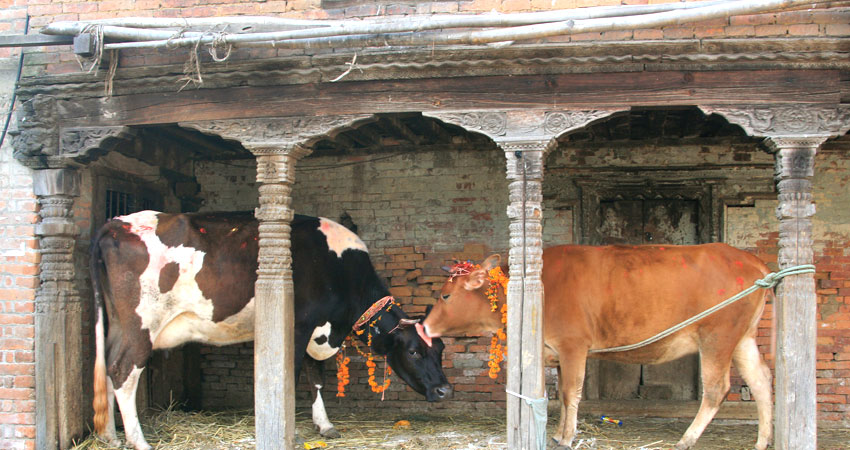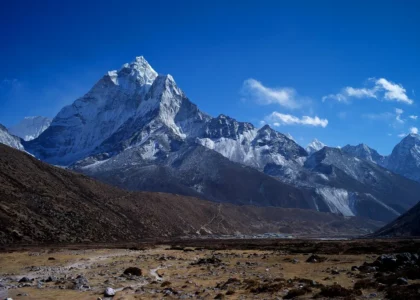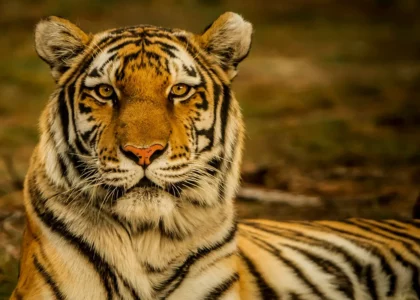National Animal of Nepal Cow

The National animal of Nepal is the Cow. The most prevalent category of big domesticated ungulates is cattle (often referred to as cows). They are a well-known contemporary Bovinae subfamily member. They are also the most common species in the genus Bos, and they are most frequently grouped as Bos primigenius.
Cows are reared as dairy animals for milk and other dairy products rather than livestock for meat. Nevertheless, transport animals (such as oxen or bullocks) are used for pulling carts and plows. The accepted national animal is the Achham cattle, a breed belonging to the Bos indicus genus.
Numerous aspects distinguish Nepal, an ancient country with a rich culture and legacy, as uniquely Nepali. Nepal has created an unrivaled identity worldwide, from religion to tolerance, peace advocacy, and heroic warriors. The country’s national animal, the Cow, symbolizes maternity, nurturing, and affection.
Nepal’s culture has compelled considerable attention to the animal kingdom since it is a nation with a rich tradition that promotes peace and love. This is well demonstrated by the fact that the Cow, Nepal’s national animal, is not only protected from all forms of abuse and killing but also acknowledged as such.
Religion is undoubtedly one of the leading associations with Cows in Nepal. Nepal is a secular society, yet the vast majority of its citizens are Hindu. This affection and devotion for the Cow is motivated by the Hindu faith. Nepalese people revere the Cow as the embodiment of the goddess Lakshmi, the patron goddess of abundance and wealth.
The national animal of Nepal is a symbol of prosperity and abundance. This is significant to the Nepalese people, who engage primarily in agriculture, and is also essential.
Both the government and the people of Nepal highly emphasize these beliefs. Since the adoption of the new constitution, it has been illegal in Nepal to slaughter cows. In addition, dairy products, the purest and healthiest, are crucial in Nepalese families. These goods are usually applied in Hindu religious rites because they are considered pure and sacred. From an economic standpoint, Cow’s milk-derived butter and ghee are shipped to India, which increases the country’s revenue.
Why is the Cow depicted as Nepal’s national animal?
Cows have almost 330 million gods and goddesses inside their bodies. The Nepalese national animal represents abundance, fertility, the mother, and milk production, among other things. In Nepal, it is regulated by legislation and safeguarded. Therefore, harming or killing a cow is not only viewed as sinful but also as a criminal offense. As a result, it is acknowledged as Nepal’s national animal.
Within the Hindu faith of Nepal and India, cows (Zebu) are worshipped. They represented plenty of wealth throughout the Vedic era. They eventually attained their current position through time. They should be treated with the same reverence as “one’s mother,” according to the Mahabharata.
The legal system started detaching beef consumption in the middle of the first millennium. Cows appear in various stories from the Vedas and Puranas, even having cow goddesses or temples dedicated to them. Krishna, the god, was born into a cow-herding family and named Govinda, which means “protector of the cows.” Additionally, Shiva is supposed to travel on the body of a bull named Nandi.
Vedic ceremonies included the use of milk and milk products. Cow products such as milk, ghee, and curd, but also cow dung and urine (Nomura), or the combination of these five (panchakarma), started to play a more significant part in ceremonial cleansing and atonement in the post-Vedic era.
According to legend, Lord Krishna, one of the names of the revered Cow, brought Surabhi to Earth to feed the children and forge a bridge between the celestial and terrestrial realms. Similarly, Ahimsa emerged during our culture’s fifth and sixth centuries, and by 200 AD, it was already forbidden to hurt or kill cows. Scientists concluded that this occurred due to the influence of a broad religious notion among people inhabiting a specific world region.
When viewed from a more technical angle, cow dung may be utilized as fuel, fertilizer, insulator, insect repellant, and construction material. The animal and its products gain value as a result. Similarly, it uses urine as a chemical fluid to eliminate microorganisms. The Cow may undoubtedly be much more valuable than it is now, especially in the modern period, when everyone is moving toward healthy and organic alternatives. These are critical explanations for why the Cow has been designated Nepal’s national animal.
The Declaration of The Cow as Nepal’s National Animal
When was the Cow designated as Nepal’s national animal? When was it a subject of worship? Some of the queries intrigue many individuals inside and outside of Nepal.
Cows have traditionally been significant in Nepal’s culture, religion, and national identity. Cows have been acknowledged as Nepal’s household animals since 1962 AD. In the Constitution of Nepal from 1962 AD, Nepal was initially referred to as a Rajashi Hindu nation. The Cow was designated Nepal’s sacred and national animal in the recently adopted 2015 constitution.
Modern Nepal was created when King Prithvi Narayan Shah of the Kingdom of Gorkha joined the minor republics. The Sanskrit word Gaurakshya, which means cow protection, is where the name Gorkha itself originates. This demonstrates the connection between animals, religion, and influential individuals like farmers.
Worship of cows in Nepal
Nepal has a rich cultural heritage. Even though Nepal is prospering and all religions are valued equally, one thing hasn’t changed: cows are still considered sacred. Worshiping the goddess Laxmi is said to make you incredibly wealthy. Given that the Cow is regarded as the goddess in Nepal, it is only natural for the population to cherish and respect the animal. This idea is honored to the point that cows are worshiped at Laxmi Puja, a festival primarily used to keep the goddess Laxmi.
On the third day of Tihar, one of Nepal’s two most significant festivals, The National Animal of Nepal, cows are adorned and worshiped in the morning. The goddess of riches, Laxmi, is worshipped in the evening. Hindus see cows as the deities Laxmi and Gau-Mata (mother). Cow’s milk, butter, urine, and dung are used during auspicious and religious events like pujas, shraddhas, rudries, and marriages.
Cows are worshipped on the day of Gai Tihar with incense, oil, light, tika, and floral garlands. After puja, they are given sumptuous meals, including the finest grass and favorite fruits. Cows are covered in tika markings of various colors all over their bodies. Generally, the colors associated with worship are red (abir) and yellow (Kesari).
Raksha Bandhan on a cow’s tail will make it easier for you to enter the afterlife. They also utilize cow manure mixed with mud (rato mato) to clean and paint the floors of homes on the same day. Sayapatri (marigold flower) garlands are used to decorate doors and windows.
Similarly, in some places, men and women use the urine of cows on their faces and heads because, believe it or not, the Cow is so worshiped here. Urine is revered as a holy gift. To preserve the surroundings, urine is frequently sprayed throughout the house. Cows are also revered by Hindus, who think that cow dung helps cleanse their homes and ward off evil.
Cows are also valued because they stand for motherhood, and their milk provides sustenance and nutrition for humanity.
Some Barriers to Declaring the Cow as Nepal’s National Animal Under A New Constitution
Nepal is a secular nation that respects and tolerates all local religions. In the Hindu faith, a cow represents the goddess Lakshmi. However, other religions, such as Christianity and Islam, do not consider cows their mother. As a result, there has been much dispute over the development and application of the law.
In actuality, individuals from many religious backgrounds have spoken out against the prohibition of cow slaughter. People of other religions have a right to access what their religion permits because it is against Hindu custom to kill cows. People have questioned the restriction, defending their position with references to Western customs since we are shifting toward Western influence and embracing contemporary cultures.
According to the almost fifty legislators that make up the Constituent Assembly of Nepal, the one-horned rhinoceros should be the nation’s national animal. The one-horned rhinoceros might serve as the country’s mascot, better-representing secularism and helping to maintain the animals’ presence in the country.
This approach appears to be an adequate response to the problem while also recognizing and defining the variety in Nepali culture as the one-horned rhino becomes increasingly uncommon within this country.
However, fundamentally, national values are significantly more critical in the country in which we live. This demonstrates that prohibition is required in light of our country’s history and traditions. However, the Cow was re-designated as Nepal’s national animal. As of right now, the Hindu religion places a similar emphasis on sacred animals as it does on people’s lives.
Legislation and regulations also exist regarding the preservation of cows. Anyone who kills a cow in a car accident must pay 500,000 rupees, which is equal to the sum due in the case of a person’s killing.
Several voices were occasionally raised in approval of the slaughter of Cows. Perhaps it is a result of Western society’s influence or probably because people are more conscious. Cows have been used to impersonate other animals. However, the government has prohibited slaughtering cows for meat and other processes, so it is not acknowledged.
Connection between farmers and Nepal’s national animal, the Cow
Tourism indeed makes up the majority of Nepal’s economic base. However, aside from this, Nepal is also considered an agricultural nation. More than 80% of people depend on agriculture for their daily needs. Their primary source of revenue is farming. In this instance, cows are crucial to the farmer’s way of life. It is hard to obtain modern infrastructure and tractors in rural Nepal due to its weak economy and mountainous terrain. As a result, farmers use cows and oxen as tractors to cultivate land and plow fields.
In Nepalese society, cows are extensively used, particularly by farmers whose livelihoods depend entirely on agriculture. Recoverable manure is excreted by cows and other livestock and utilized as fertilizer. Additionally, dung was used as fuel for cooking. The yearly heat produced by this dung, a primary fuel rural homemakers use, is comparable to tons of coal, wood, or kerosene.
These fuels cannot be considered viable alternatives to cow dung since Nepal only has modest oil and coal resources and is experiencing significant deforestation. While using dung in the kitchen may not appeal to Westerners, Nepalese women think it is a beautiful cooking fuel because it fits in well with their daily routines. The recommended heat source is cow dung, which produces a food-safe, long-lasting fire that burns cleanly and slowly.
Similar to this, many meals in the kitchen use products made from Cow’s milk. Instead of refined oil, most Nepalese recipes use ghee, cultured butter that is good for your health.
Cow excrement also serves at least one significant purpose: cleaning the home. Mud makes up the majority of houses in rural areas. Nepalese people prefer using cow dung to cover their home’s floors to clean such a home since it can be made into a paste by mixing it with water.
All the information about the National Animal of Nepal, the Cow, Achham Cattle
Seven distinct indigenous cow breeds have been identified in Nepal. Lulu, Pahadi, Siri, Khailia, Achham, and Yak are Terai cattle. The Achham cattle (Bos indicus), one of them, are among the rarest and smallest breeds of cows in the world.
However, Achham cattle, a species of the Bos indicus breed, are referred to as national animals. Zebu cattle of the Achham breed are unique to the Achham area of Nepal. A tiny breed of livestock, Achham cattle are under 1 meter tall at the withers. Because it is barely nine fists long from hoof to hump, it is also known as the Naumuthe cow.
The Achhami cattle (Bos indicus) are among Nepal’s distinctive flora and wildlife. They are mainly utilized for milk production since they are ideal for hilly areas with minimal input systems. Body colors range from black to white, including spotted black and white, brown, grey, and black.
The National Animal of Nepal Cows weigh an average of 110 kg and have a wither height of 88 cm, according to the Nepal Agriculture Research Council’s 2005 annual report on animal breeding. Bulls typically measure 97 cm at the withers and weigh 150 kg. They are raised by farmers in the Achham, Bajhang, Bajura, and Doti districts of Nepal’s Far Western Development Region.
An indigenous domestic cattle species or subspecies of the Indian subcontinent is the Zebu (Bos indicus or Bos taurus indicus), sometimes referred to as indicine cattle or humped cattle.
Their enormous dewlap distinguishes Zebu, with fatty hump on the shoulders and occasionally drooping ears.
Because they survive high temperatures, they are raised as pure Zebu and hybrids with taurine cattle, the second major domestic cattle species in all tropical nations.
Zebu are utilized as cattle for meat, dairy, and draught work, as well as for their byproducts, such as skins and dung for manure and firewood. Some little breeds, like the miniature Zebu, are also kept as pets. Texas A&M University scientists cloned a zebu successfully in 1999.
Zebu typically reaches reproductive maturity at 29 months of age. This is based on how their bodies have evolved to tolerate the stress of nursing and pregnancy. Early pregnancy and childbirth can overstress the body and perhaps decrease lifespans. The typical gestation period for a calf is 285 days; however, this might vary based on the mother’s age and diet.
Given that male calves are carried more extended than female calves, the calf’s gender may also impact the carrying time. The animal’s general health is influenced by location, breed, body weight, and season, which may also affect the gestation length.
The National animal of Nepal, Cows, is utilized in Nepal as dairy cattle. Draught animals and riding animals, as well as for byproducts like skins, dung for fuel and manure, and horns for things like knife handles. According to estimates from 1998, there were 65.7 million head of carriage cows in India. Zebu cows often produce little milk. They don’t start making much milk until they mature later in life. Milk output usually rises when Zebu cattle are bred with taurine cattle.
Cows are produced in several nations worldwide to produce meat, milk, and leather. However, the slaughter of cows is prohibited in Nepal since they are revered as holy animals.
The domestication of the Cow as a farm animal began in the Middle East some 10,000 years ago. The Cow is an herbivorous animal that eats grass, herbs, seeds, and leaves for nourishment. Most of its food is made up of roots from Fabaceae and grasses. The Cow may get the required nutrients in the grasslands, including hay, clover, and water. The Cow is fed nine times each day.
Some Interesting Facts about the National Animal of Nepal Cows
Cows are amazing creatures with a variety of ways to express themselves. Here are some intriguing details regarding this National animal of Nepal
With a population of 863 and a height of less than 1 m, Achham cattle species cows are the smallest indigenous cattle breed in the world. They are exclusively found in the Khaptad buffer zone in the Achham region of Nepal.
- Achham animals give farmers sustenance through milk, energy for agricultural endeavors, and dung for preserving and boosting soil fertility.
- These locally bred Achham cattle comprise a minor fraction of the nation’s cattle population. They are primarily found in western Nepal’s mid- and high-hills of Achham, Bajura, Bajhang, and Doti Districts.
- These kinds of cows are often extremely clever creatures with lengthy memories. Studies have shown that they form friendships, communicate in complicated social ways, and can recall unpleasant interactions with other cows.
- It is regarded as sustainable animal husbandry with a promising future since it emphasizes the natural biodiversity’s capacity for resilience. These animals’ diets in the hills consist of fodder trees, straw, and tiny concentrate, while high-producing animals can get concentrate feed.
- Only 12% of this is exotic (pure and hybrid); the remainder is indigenous.
- The smallest breed of Cow is the Achham, which stands less than 1 meter tall at the withers.
- They are appropriate for low-input systems and hilly terrain.
- Body color ranges from black to white, including shades of brown, grey, white, and black and white with spots.
- Their ear is straight and measures 17 cm on average. Its demeanor ranges from submissive to ferocious.
- At the age of nine years, Achham cattle had a wither height of 90.8 0.96 cm. At 8, the maximum body weight and length were also 149.38 5.1 kg and 98.07 1.52 cm, respectively.
- When they figure out a problem’s solution, they become enthusiastic. They are also incredibly social creatures that create hierarchies and form well-organized social groups with guidelines.
- The warmth of their nostrils is another way they express their feelings. According to a recent study, petting the cows in their favorite areas while they were relaxed allowed you to enjoy the pleasant sensation while also causing the nasal temperature to drop.
- Compared to cows that lack access to fundamental necessities, happy cows who live in acceptable settings with access to shade and a sufficient degree of health are more productive.
- It has been discovered that cows move their ears in four different directions, another way they may express their attitude. Two: while at ease and when paying attention.
- They may make up to 55 liters of saliva each day. They consume and chew food for 6 to 7 hours each day.
- They can consume 130 liters of water daily and have an exceptional sense of smell that allows them to detect objects at a distance of 10 kilometers.
- A grown cow only has eight teeth.
- They may give birth to twins, just like humans.
- Cows may develop compassion and empathy for people and other animals.
Some significant issues concerning the National animal of Nepal cows
Although cows are incredibly beneficial and have contributed to many fields, there are still significant issues with cows in Nepal that are worsening daily. The primary issue nowadays is the large number of stray cows in Nepal, primarily because it is illegal to kill them, and there are no government programs in place to take care of them. A dairy farmer even freed a paralyzed cow that had ceased giving milk.
The stray Cow is not just a concern in the Capital. All around the country, people may see cows on the streets. Numerous regions of the nation where local administrations have attempted to limit the stray cow population often report news of significant cattle deaths. In four temporary shelters that farmers constructed in certain areas, more than a thousand cows perished every year from malnutrition and dehydration.
Every year, hundreds of stray cows around the nation pass away, mainly as a result of car accidents, thirst, gastrointestinal problems, and diseases. It is prohibited to slaughter cows for food or any other reason since they are revered as holy animals and have legal protection. Cows are, therefore, sometimes released by dairy farmers once they stop milking or if they grow old.
The Cow is the holy National animal of Nepal
If stray cows are included, there are thought to be more than 7.3 million cows in the nation. The fact that the Cow is still revered as a holy animal in secular Nepal accounts for the high number of homeless animals.
Besides, the primary obstacles to maintaining these priceless and significant breeds include poor management, ineffective breeding strategies, cross-breeding, a lack of increasing focus on exploration and investigation, a decline in farmers’ interest in raising livestock, illegal trade to Tibet for slaughter, etc. As a result, the breed is in a critically endangered state.
The owners of these cows should be held responsible since more stray animals are in poor condition. However, more people than just the owners need to accept accountability. Considering that the Cow is Nepal’s national animal, it is also the government’s responsibility to ensure a suitable system for managing stray cows.
Numerous people claimed that the Cow should no longer be considered Nepal’s national animal when the 2015 constitution was written. Even Janajati activist Ang Kaji Sherpa said that the legislation forbade Adivasi-Janajatis and other marginalized communities from consuming beef by designating the Cow as the nation’s animal. The Constituent Assembly ultimately resolved to follow the established course. After much deliberation, they chose the Cow as Nepal’s national animal since it is highly respected and deeply ingrained in its culture.
The traditional Hindu devotion to the Cow persisted even after the nation became a secular republic, resulting in an explicit ban on the slaughter of cows for meat or any other purpose.
Nepal may have a primarily Hindu population, but it also has a sizable Buddhist, Muslim, Christian, and atheist population. The consumption of beef, which is offered in several stores and eateries across the Capital, is not prohibited by these groups. However, all of this beef is imported since, by the Civil Code, the killing of cows and any inflicting of suffering upon them are regarded as “heinous crimes.”
Conclusion
Regarding nationality and religion, the National animal of Nepal, the Cow, is one of Nepal’s most valued and revered animals. There is no finer icon than motherhood, a universal representation of nurturing. The National animal of Nepal embodies not only Hinduism and its principles but also Nepal and its traditions and moral standards. However, as Nepal’s national animal, the Cow is the ideal emblem of peace and love. Instead of only focusing on the animal’s name as the national animal, we must comprehend the animal’s significance.
Given all of this, it is simple to conclude that the gods save cows because they are holy, and doing so is more advantageous than killing them. In actuality, cows—which are frequently filthy—roam freely through the streets, on temple steps, and in the middle of the road. And they may be located in the most unlikely locations, where nobody dares to disturb them, no matter how bold.
Let’s now evaluate the Cow’s advantages and disadvantages. Cows are considerably more productive and beneficial to humans than cows. The Cow, meanwhile, serves just a million purposes.
Other animals or endangered species might be considered national animals of Nepal, like the rhinoceros, tiger, or lion. They are not as helpful as cows, but they are still quite significant from an ecological standpoint. So why all the controversy over naming the Cow the national animal? Let’s avoid approaching it from a religious or communal perspective. When viewed scientifically, though, it all makes perfect sense. We can arrange a short tour of cow farming in Nepal.
Best Price Guaranteed, Easy to change Date, Instant Confirmation
Book This Trip Have Questions?
Have Questions?Talk to Expert
Meet Mr. Purushotam Timalsena (Puru), Nepal's best trek and tour organizer, who has been working in the Himalayas for more than 24 years.
WhatsApp/Viber +977 98510 95 800











